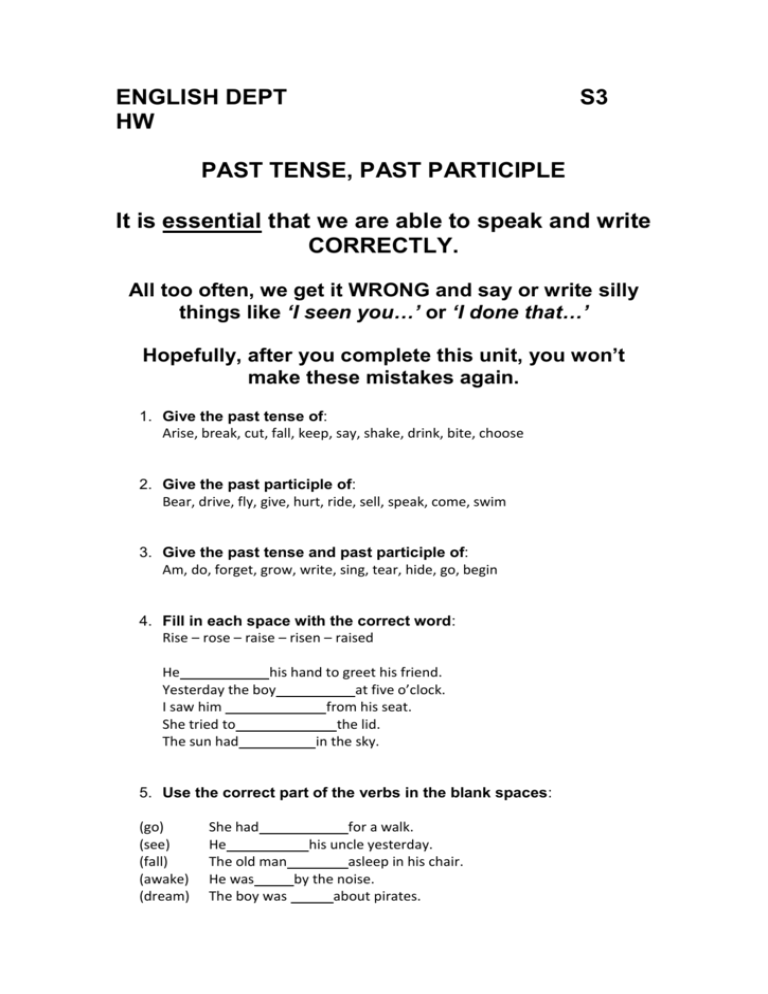


In other words, the form ‘sung’ is the past participle form of the verb ‘sing’. In the third sentence, past perfect tense is used and the verb in the past perfect tense ‘sung’ is used. In the second sentence, past tense is used and the verb in the past tense form ‘sang’ is used. In the first sentence, present tense is used and the verb in the present tense form is used. This perfect tense could be present perfect, past perfect or future perfect. On the other hand, past participle is a grammatical form of a verb when a perfect tense is used. The action of looking took place some time ago. In the second sentence, you can see that the action of looking was over when somebody said ‘He looked at her friend’. In the first sentence, the action of giving is completed when somebody said ‘I gave a book to Francis’. Past tense indicates the completed nature of an action. In both the sentences given above, simple past tense is used. Past is sometimes referred to as simple past as in the sentences given below: That is why it is necessary to study the past and past participle forms of the verbs by heart. However, for irregular verbs the past and past participle of the verbs differ. For regular verbs, both past and the past participle are the same. In English, the verb has three forms present, past, and the past participle. What they both have in common is that both of them affect the verb. Past is used for one particular purpose while the past participle is used for another. I hope to see you inside the course, and I look forward to reading your comments what these irregular verbs.Past and Past participle are two grammatical forms that show difference between them in usage. This is one of the best ways to get direct feedback from a teacher on your English. You can click on the link in this video to see the lesson list.Īn extra special part of that course is that each lesson includes a writing task where you can send me your answer, a paragraph or two of written English, and I will correct it. If you’d like to learn all of the verb tenses, as well as more complex structures like conditionals and inverted sentence structures and some of the other interesting structures we use in English, check out my Advanced English Grammar Course, which is covers a lot of topics in English grammar. English has a ton of irregular verbs, and it’s really easy to make mistakes with them, but with more practice it will become more natural. Why don’t you try writing a comment? Write a sentence or two in the past or in the present perfect using one or two of these irregular verbs. It’s spread in the present, spread in the past, and spread in the past participle, which is used in the present perfect. Has, and then the past participle is spread. Maybe you’re watching the news about a disease and the newscaster says, It’s put in the present, put in the past, and put in the present perfect. The past participle of these verbs is really easy it’s just the same as it is in the present and the past.
#GIVE PAST TENSE AND PAST PARTICIPLE PLUS#
To form the present perfect, we use have or has plus the past participle. That’s also the case in the present perfect. Those are three examples in the simple past. There are a few more but these are the most common ones. There are only a few verbs like this in English, and some of the more common ones are put, let, set, hit, cost, hurt, shut, quit, split, and spread. In the past, talking about the t-shirt you bought yesterday, you would say, “It cost $10.” If you’re shopping right now and you’re looking at a t-shirt in front of you in the present, then you would say, “It costs $10” in the present. Now this verb does change in the present when the subject is he, she, or it. The verb cost is cost in the present, cost in the past, and cost in the past participle, which is what we use with the present perfect.

I’ve seen a lot of students make the mistake of writing a sentence like this:

Today I’m going to teach you all about some special irregular verbs in English that don’t change from present to past and past participle. Hello students, it’s Shayna, your teacher from. Advanced English Grammar Course Transcript:


 0 kommentar(er)
0 kommentar(er)
